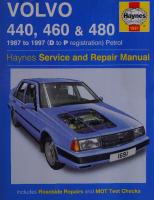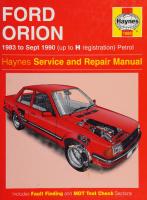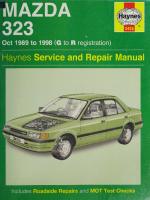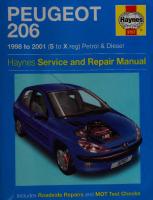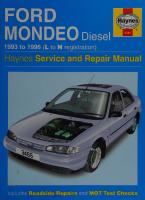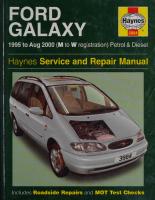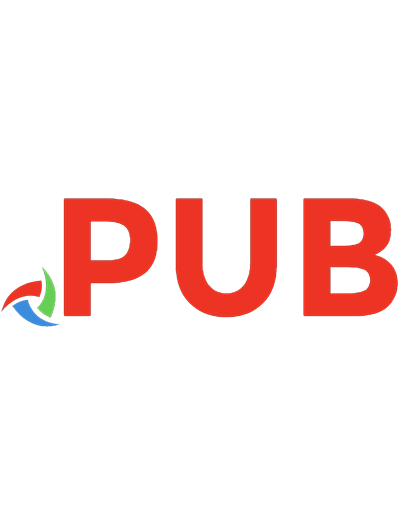Haynes Rover 200 Series Service and Repair Manual 1844252574, 9781844252572
“1 volume (various pagings) : 27 cm "Models covered - Rover 211, 214, 216, 218 & 220 Hatchback models with pet
234 37 53MB
English Pages 372 Year 2005
Polecaj historie
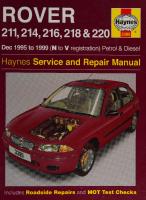
- Author / Uploaded
- Spencer Drayton
- Steve Rendle
- Categories
- Technique
- Transportation: Cars, motorcycles
Citation preview
Includes
ide
R
elale
and not forgetting... We don’t just publish car manuals, you know! In addition to the hundred million worldwide, Haynes also produce a wide range of practical books and manuals computing, caravanning, cycling and driving tuition — and there’s our innovative as well. No matter what the subject, our essential no-nonsense, easy-to-follow
plus car manuals we have sold on subjects such as home DIV, and highly successful Family Series approach remains the same.
je
BRAKES
¢
Car Restorer’s
CARAVAN
Scooters eeicad
: Manual ===
(sa) 7
ae ep
We also publish and distribute hundreds of books and DVDs covering general motoring and transport subjects, including all aspects of motorsport, classic cars, sports cars, motorcycling, military vehicles, aviation, model cars, cycling, golf, history and much, much more.
SPIRIT OF} THE BLUE} PeteR ATERST
nekPERT NaC
] z
‘LANDROVER| EXPEDITIONS | TO GO OFF-ROADING IN THE UK [2 wuns2r
. 1 Formula
WHERE
Check out our website at www.haynes.co.uk to find your nearest stockist or to view or download our online catalogue. All Haynes publications are available variously through car accessory shops, book stores and mail order outlets.
Haynes Publishing, Sparkford, Yeovil, Somerset BA22 7JJ, England Telephone France
(01963) 442030 ¢ E-mail
01 47 17 66 29 * Sweden
[email protected]
018 124016 © USA
* Website
805 498-6703 « Australia
www.haynes.co.uk
613 9763-8100
Illegal Copying It is the policy of Haynes Publishing to actively protect its Copyrights and Trade Marks. Legal action will be taken against anyone who unlawfully copies the cover or contents of this Manual. This includes all forms. of unauthorised copying including digital, mechanical, and electronic in any form. Authorisation from Haynes Publishing will only be provided expressly and in writing. Illegal copying will also be reported to the appropriate statutory authorities in whichever jurisdiction the offence takes place.
|
IAA 132hdhiadhie 8303
Rover 200 Series
Service and Repair Manual Spencer Drayton and Steve Rendle Models covered
(3399 - 368 - 12AH3)
Rover 211, 214, 216, 218 & 220 Hatchback models with petrol and turbo-diesel engines, including special/limited editions Petrol engines: 1.1 litre (1120 cc), 1.4 litre (1396 cc), 1.6 litre (1589 cc) & 1.8 litre (1796 cc) Turbo-diesel engines: 2.0 litre (1994 cc) Does not cover 200Vi models with 1.
NORTHUMBERLAND LIBRARY
COUNTY
30132013158303
629.2872
£17.99
ABODE
© Haynes Publishing 2005 A book in the Haynes Service and Repair Manual Series All rights reserved. No part of this book transmitted in any form or by any mechanical, including photocopying, information storage or retrieval system, writing from the copyright holder.
may be reproduced or means, electronic or recording or by any without permission in
ISBN 1 84425 257 4
Bit EN dats Haynes Publishing Sparkford, Yeovil, Somerset BA22 7JJ, England Haynes North America, Inc 861 Lawrence Drive, Newbury Park, California 91320, USA Editions Haynes 4, Rue de I'Abreuvoir
92415 COURBEVOIE CEDEX, France
British Library Cataloguing in Publication Data
Haynes Publishing Nordiska AB
A catalogue record for this book is available from the British Library
Box 1504, 751 45 UPPSALA, Sweden
Contents LIVING WITH YOUR
ROVER 200
Introduction
Page
0294
Safety First!
Page
0e5
Roadside Repairs Introduction
Page
06
If your car won’t start
Page
0*6
Jump starting
Page
0Oe7
Wheel changing
Page
0e*8
Identifying leaks
Page
0e*9
Towing
Page
O29
Page
0°10
Page
0°10
Weekly Checks Introduction Underbonnet check points
‘
Engine oil level
Page
0e11
Power steering fluid level
Page
0Oe11
Brake fluid level
Page
0e12
Screen washer fluid level
Page
0e12
Coolant level
Page
0°13
Wiper blades
Page
0°13
Tyre condition and pressure
Page
0¢14
Battery
Page
0015
Electrical system
Page
0015
Lubricants, Fluids, Capacities and Tyre Pressures
Page 0°16
MAINTENANCE Routine Maintenance and Servicing Rover 200 petrol models
Page
1Ae¢1
Maintenance schedule
Page
1Ae93
Maintenance procedures
Page
1Ae5
Page
1Be1
Maintenance schedule
Page
1Be3
Maintenance procedures
Page
1Be5
Rover 200 diesel models
Illegal Copying It is the policy of Haynes Publishing to actively protect its Copyrights and Trade Marks. Legal action will be taken against anyone who unlawfully copies the cover or contents of this Manual. This includes all forms of unauthorised copying including digital, mechanical, and electronic in any form. Authorisation from Haynes Publishing will only be provided expressly and in writing. Illegal copying will also be reported to the appropriate statutory authorities.
Contents REPAIRS & OVERHAUL Engine and Associated Systems K-series petrol engine in-car repair procedures a e a a s Diesel engine in-car repair procedures
Page 2Ae1 ee Page 2Be1
Petrol engine removal and general overhaul procedures
Page
2Ce1
Diesel engine removal and general overhaul procedures
Page
2De1
Cooling, heating and ventilation systems
Page
3e1
Page
4Ae1
Fuel and exhaust systems - petrol engines
|
Fuel and exhaust systems - diesel engines
Page
4Be1
Emission control systems
Page
4Ce1
Starting and charging systems
Page
5Ae1
Ignition system - petrol engines
Page
5Be1
Pre-heating system - diesel engines
Page
5Ce1
Transmission Clutch
Page
6¢e1
Manual transmission
Page
7Ae1
Automatic transmission
Page
7Be1
Driveshafts
Page
8e1
Braking system
Page
9e1
Suspension and steering
Page
10e1
Bodywork and fittings
Page
11e1
Body electrical systems
Page
12¢1
Wiring Diagrams
Page 12°21
Brakes and Suspension
Body Equipment
REFERENCE Dimensions and Weights
Conversion Factors
Page
Page
REFe1
REFe2
Buying Spare Parts and Vehicle Identification
Page
REFe3
General Repair Procedures
Page
REFe4
Jacking and Vehicle Support
Page
REFe5
Radio/cassette Anti-theft System
Page
REFe5
Tools and Working Facilities
Page
REFe6
MOT Test Checks
Page
REFe8
Fault Finding
Page REFe12
Glossary of Technical Terms
Page REFe19
Index
Page REF*24
oe4 INtroduction
employing mechanical fuel injection, whilst 220Di and 220SDi modeis are fitted with a 105PS version of the same engine, employing an airto-air intercooler and electronic fuel injection. in 1989. At its launch in December 1995, the Rover 200 was available Two types of five-speed manual transmission are used; the PG1 unit in three and five door Hatchback body styles, powered by 1.4 litre . is fitted to diesel and 1.8 litre petrol models, with the RG665 unit fitted to eight-valve, 1.4 litre sixteen-valve and 1.6 litre sixteen-valve variants of the remainder of the range. The complete engine/transmission unit is the proven ‘K-series’ petrol engine. A range of diesei-engined models mounted transversely across the front of the car, with the transmission was launched at the same time, powered by two variants of the new mounted at the left-hand end of the engine. Drive to the front wheels is 2.0 litre turbocharged ‘L-series’ diesel engine. The range was extended via unequal-length, solid driveshafts. _ in 1997 by the inclusion of the 218 model, fitted with a 1.8 litre variant The front suspension incorporates coil-over-damper MacPherson ’_ of the sixteen-valve ‘K-series’ engine, and in 1998 by the addition of struts and an anti-roll bar. The hub carriers are located by tie rods and the 211 model, powered by a multi-point fuel injected, 1.1 litre variant single transverse lower arms. The rear suspension is of the torsionof the eight-valve ‘K-series’ engine. The flagship 200Vi model, fitted beam type, utilising coil-over-damper struts and tubular steel trailing with a 1.8 litre ‘K-series’ engine, featuring variable valve control (VVC), arms linked via a single twist beam axle. The whole assembly is bolted is not covered in this Manual. to the underside of the vehicle via composite rubber bushes and All petrol engined models are fitted with eight-valve, single overhead angled pivot mountings, which endow the car with ‘in-phase, passive camshaft or sixteen-valve double overhead camshaft versions of the ‘K’ rear steering’ for improved handling during cornering. Diesel and 1.8 series engine, controlled by the Rover/Motorola Modular Engine litre petrol models are also fitted with a rear anti-roll bar. Management System (MEMS) with multi-point fuel injection (MPi). All Braking is by discs at the front and drums at the rear, with a dualversions of the engine are able to accept a full range of emission control circuit hydraulic system. On all models in the range, an Anti-lock systems, up to and including a three-way regulated catalytic converter. Two derivatives of the ‘L-series’ turbocharged diesel engine are Braking System (ABS) was offered as an optional extra. Where ABS is available; 220D and 220SD models are fitted with an 86PS version, fitted, braking is by discs both at the front and rear. The Rover 200 Hatchback
model
covered
in this Manual
is an
evolution of the original Rover 214/216 Hatchback model first launched
Your Rover 200 Manual The aim of this manual is to help you get the best value from your vehicle. It can do so in several ways. It can help you decide what work must be done (even should you choose to get it done by. a garage), provide information on routine maintenance and servicing, and give a logical course of action and diagnosis when random faults occur. However, it is hoped that you will use the manual by tackling the work yourself. On simpler jobs, it may even be quicker than booking the car into a garage and going there twice, to leave and collect it. Perhaps most important, a lot of money can be saved by avoiding the costs a garage must charge to cover its labour and overheads. The manual has drawings and descriptions to show the function of the various components, so that their layout can be understood. Then the tasks are described and photographed in a clear step-by-step
sequence. References to the ‘left’ or ‘right’ of the vehicle are in the sense of a person in the driver’s seat facing forward.
Acknowledgements Thanks are due to Draper Tools Limited, who supplied some of the workshop tools, and to all those people at Sparkford who helped in the production of this Manual. ROVER
Rover 211
We take great pride in the accuracy of information given in this manual, but vehicle manufacturers make alterations and design changes during the production run of a particular vehicle of which they do not inform us. No liability can be accepted by the authors or publishers for loss, damage or injury caused by any errors in, or omissions from the information given.
Safety first! o-s Working on your car can be dangerous. This page shows just some of the potential risks and hazards, with the aim of creating a safety-conscious attitude.
General hazards
Fume or gas intoxication
Scalding e Don’t remove the radiator or expansion tank cap while the engine is hot. e Engine oil, automatic transmission fluid or power steering fluid may also be dangerously hot if the engine has recently been running.
Burning ¢ Beware of burns from the exhaust system and from any part of the engine. Brake discs and drums can also be extremely hot
immediately after use.
Crushing e When working under or near a raised vehicle, always ERG supplement the jack with axle stands, or use
— [=
drive-on ramps. Never venture
® Mains voltage is also dangerous. Make sure that any mains-operated equipment is correctly earthed. Mains power points should be protected by a residual current device (RCD) circuit breaker.
e Exhaust fumes are poisonous; they often contain carbon
Gee .
ci
monoxide, which is Bees rapidly fatal if inhaled. Never run the engine ina confined space such as a garage with the doors shut. ® Fuel vapour is also poisonous, as are the vapours from some cleaning solvents and paint thinners.
Poisonous or irritant substances s!ig
FS
(Gag sin =)
e Avoid skin contact with battery acid and with any fuel, fluid or lubricant, especially antifreeze, brake hydraulic fluid and Diesel fuel. Don’t syphon them by mouth. If such a substance is swallowed or gets into the eyes, seek medical advice. e Prolonged contact with used engine oil can cause skin cancer. Wear gloves or use a
=
@ Take care if loosening or tightening hightorque nuts when the vehicle is on stands. Initial loosening and final tightening should be done with the wheels on the ground.
barrier cream if necessary. Change out of oilsoaked clothes and do not keep oily rags in your pocket. e Air conditioning refrigerant forms a poisonous gas if exposed to a naked flame (including a cigarette). It can also cause skin burns on contact.
Fire
Asbestos
° Fuel is highly flammable; fuel vapour is
e Asbestos dust can cause cancer If inhaled or swallowed. Asbestos may be found in gaskets and in brake and clutch linings. When dealing with such components it is safest to assume that they contain asbestos.
eae
under a car which is only supported by a jack.
explosive.
© Don’t let fuel spill onto a hot engine. ¢ Do not smoke or allow naked lights (including pilot lights) anywhere near a vehicle being worked on. Also beware of creating sparks (electrically or by use of tools). e Fuel vapour is heavier than air, so don’t work on the fuel system with the vehicle over an inspection pit. e Another cause of fire is an electrical overload or short-circuit. Take care when repairing or modifying the vehicle wiring. © Keep a fire extinguisher handy, of a type suitable for use on fuel and electrical fires.
Electric shock e Ignition HT voltage canbe
dangerous, especially to
és ng
the engine running or the ignition switched on.
Air bags e Air bags can cause injury if they go off accidentally. Take care when removing the steering wheel and/or facia. Special storage instructions may apply.
Diesel injection equipment e Diesel injection pumps supply fuel at very high pressure. Take care when working on the fuel injectors and fuel pipes.
Warning: Never expose the hands, face or any other part of the body to injector spray; the fuel can penetrate the skin with potentially fatal results.
¢ Do use eye protection when using power
e Dont attempt to lift a Keay component: which may be beyond your pe os)get assistance.
tools, and when working under the vehicle. @ Do wear gloves or use barrier cream to — protect your hands when necessary.
.
@ Don’t rush to finish a job, or take unverified short cuts.
° Don't use ill-fitting tools which may slip
vehicle.
and cause injury.
© Do keep loose clothing and long hair well out of the way of moving mechanical parts.
where someone can trip over them. Mop
electrical system. e Do ensure that any lifting or jacking
5 j
e Batteries contain sulphuric acid, which attacks clothing, eyes and skin. Take care when topping-up or carrying the battery. e The hydrogen gas given off by the battery is highly explosive. Never cause a spark or allow a naked light nearby. Be careful when connecting and disconnecting battery chargers or jump leads.
DON’T
e Do remove rings, wristwatch etc, before working on the vehicle — especially the
people with heart ff problems or a Ti pacemaker. Don’t ez work on or near the ignition system with
The battery
50.
that all is well when working alone on the
Pa +
Hydrofluoric acid e This extremely corrosive acid is formed when certain types of synthetic rubber, found in some O-rings, oil seals, fuel hoses etc, are exposed to temperatures above 400°C. The rubber changes into a charred or sticky substance containing the acid. Once formed, the acid remains dangerous for years. If it gets onto the skin, it may be necessary to amputate the limb concerned. e When dealing with a vehicle which has suffered a fire, or with components salvaged from such a vehicle, wear protective gloves and discard them after use.
Remember...
e Do get someone to check periodically
He
Special hazards
equipment has a safe working load rating adequate for the job.
e Don’t leave tools or parts lying around
up oil and fuel spills at once. ¢ Don’t allow children or pets to play in or near a vehicle being worked on.
o¢ Roadside repairs The following pages are intended to help in dealing with common roadside emergencies and breakdowns. You will find more detailed fault finding information at the back of the manual, and repair information in the main chapters.
If your car won’t start even though the starter motor turns as normal
If your car won’t start and the starter motor doesn’t turn L] If it’s a model with automatic transmission, make sure the selector is in ‘P’ or ‘N’. ~ (1 Open the bonnet and make sure that the battery terminals are clean and tight. L} Switch on the headlights and try to start the engine. If the headlights go very dim when you’re trying to start, the battery is probably flat. Get out of trouble by jump starting (see next page) using a friend’s car.
Hees) A bad earth can cause intermittent problems in several circuits at the same time and can be difficult to trace. Check that the earth point bolts are secure and free from corrosion
Check
that
the
Is there fuel in the tank? Is there moisture on electrical components under the bonnet? Switch off the ignition, then wipe off any obvious dampness with a dry cloth. Spray a water-repellent aerosol product (WD-40 or equivalent) on ignition and fuel system electrical connectors like those shown in the photos. Pay special attention to the ignition coil wiring connector and HT leads. (Note that Diesel engines don’t normally suffer from damp.)
spark
plug
HT
lead
Check the security and condition of the battery connections
connections are clean and secure
The ECU wiring connector can cause problems if dirty, or poorly connected
=
Nt
ee
Check (with the ignition switched off) that all electrical connections are secure and spray them with a water-dispersant spray (such as WD40) if you suspect a problem due to damp
NECA
-
2
EN
f
11.75
Os s
:
WN yy
